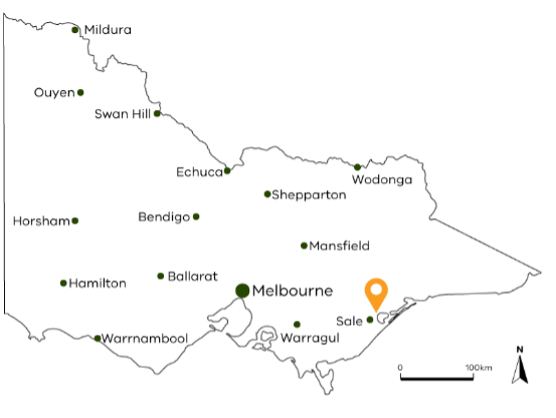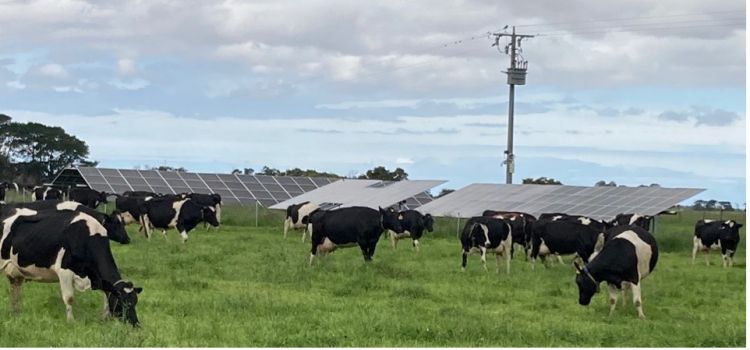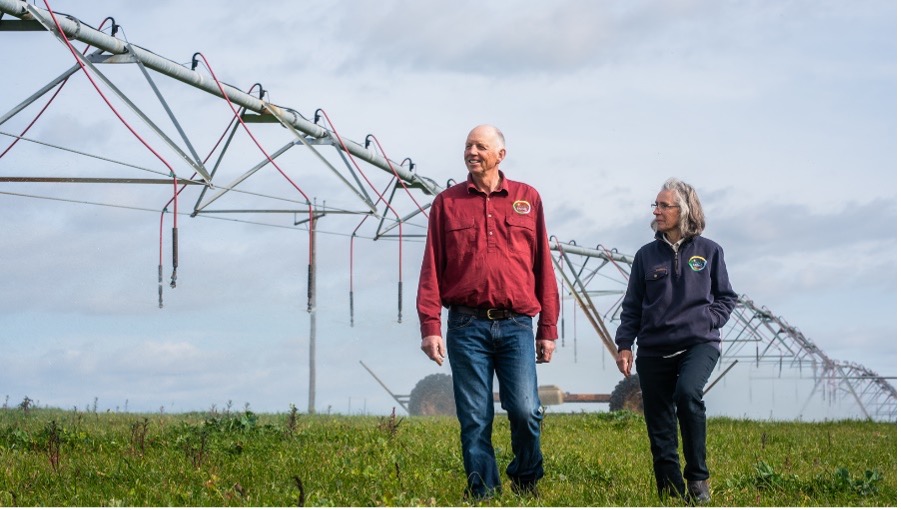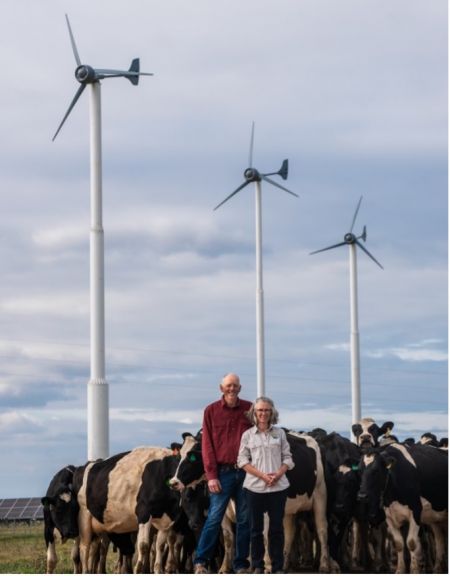Weighing up low-emissions milk production

About Wilandra Farms
- Wilco Droppert and Sandra Jefford operate Wilandra Farms, a dairy enterprise at Clydebank near Sale in Gippsland.
- Wilandra Farms milks 380 cows on 210 ha under centre pivot and K-line irrigation.
- The certified organic farm grows pasture that is a mix of chicory, plantain, lucerne, mixed grasses and clover.
- Soils are sandy loam and average annual rainfall is 600 mm but it can vary, so irrigation is in use to maintain production stability.
- The farm applies effluent from a settlement pond system using irrigation equipment.
- 15 ha of 1 to 20 year-old trees plus older remnant Red Gums provide shade and shelter to stock.. Ten ha of fenced wetlands and 5 dams provide habitat for wildlife. The trees and wetland areas help store carbon.
- On-farm solar and wind turbines help to reduce grid-power usage from running irrigation pumps.
- Wilandra Farms hopes to further reduce emissions by monitoring the weight of their herd to improve milk production and reduce overall emission intensity of product.
Farming and carbon emissions
In Australia, there’s a big focus on how farms manage greenhouse gas (GHG) emissions and store carbon. Efficient production to manage and reduce emissions is becoming increasingly important.
Agriculture Victoria’s On-Farm Emissions Action Plan Pilot is working with Victorian farmers to know, understand, and act on their farm GHG emissions.
Wilandra Farms’ focusses on-farm sustainability and its impact on the broader environment. Seven years ago, the owners moved to an organic farming system and are now organic certified.
In 2021, the owners measured the soil carbon levels to get a baseline for capturing soil carbon and storage (sequestration) opportunities. Their soil carbon levels across the farm were 2.7 to 5.4% for the top 30 cm of soil.
They put in place wind turbines and solar panels to help generate electricity and reduce their grid power usage after participating in Agriculture Victoria’s Agriculture Energy Investment Program audit. The equipment generates 240 kW of electricity.

Wilco and Sandra enjoy showcasing this technology to others to build wider industry awareness.
They were drawn to the Agriculture Victoria On-Farm Emissions Pilot program to learn more about how the various parts of their farm generates emissions and learn what management options exist to reduce these. ‘We’d heard that enteric methane emissions make up a big part of a farm’s emission number, and wanted to see how the numbers are here’, said Sandra.
Enteric methane is a gas belched during the digestion process within ruminant animals.
I’d rather have the information and knowledge, than be in the dark and not know.

Know your number
‘Know your number’ is a way to measure the greenhouse gas (GHG) emissions from a farm using a special tool like the Greenhouse Accounting Framework (GAF) calculator.
This number is the total amount of carbon dioxide equivalents (CO2-e) produced by the farm each year. It includes three types of emissions, called Scopes:
- Scope 1: Emissions from livestock (like enteric methane from sheep and cows), nitrous oxide from nitrogen fertilizer application, urine and dung and carbon dioxide from fossil fuel use.
- Scope 2: Emissions resulting from the electricity the farm uses.
- Scope 3: Emissions created in manufacturing products the farm buys (embedded).
Farms can also capture and store carbon in trees and soils, a process known as carbon sequestration. This captured carbon can be used to balance against their emissions, which is called ‘insetting’.
The 2021-22 emissions analysis at Wilandra Farms estimated that enteric methane from their cows was responsible for 68% of the net on-farm emissions. Methane from animal waste added a further 14% to this total.
Nitrous oxide emissions from urine, dung and crop residues accounted for around 14% of emissions. Carbon dioxide from electricity, lime and urea was 3% of the total emissions.
Fifteen hectares of trees provided a 9% inset advantage to the total annual farm emissions for 2021-22. The farm’s tree belts capture 223 tonnes CO2-e per year.
Emissions intensity is a measure of the emissions per unit of product. Wilandra Farms’ milk production emission intensity was below* the industry average, where per kilogram of fat and protein corrected milk (FPCM), net emissions intensity was 0.86 kg CO2-e per kg FPCM (*note a lower emissions intensity figure is the goal).
In Gippsland, the industry average is 0.91 kg CO2-e per kg FPCM1. For meat production, this was 3.31 kg CO2-e per kilogram of liveweight (LW), whereas the industry average is 4.2 kg CO2-e per kg LW1.
‘We have managed to reduce emissions previously associated with fossil fuels, but enteric methane and other emissions are still considerable’, said Sandra.
Within the emissions action plan, Wilandra has identified 2 goals, these being to reduce their livestock’s enteric methane and decrease overall emissions intensity.
‘The number of cattle we own, and how big they are have a big impact on the emissions number’, said Sandra. ‘So, we need to do quarterly stocktakes of numbers of cattle and record their average weights. Easy, but we just have to make time to do it’.
Acting to reduce emissions
A Pilot Action Plan Grant is supporting the installation of weighing equipment across the farm’s three properties and upgrading the dairy’s cattle crush.
Wilandra can track animal weights over time by transferring recorded weights to the farm’s Allflex management system. The farm can then customise their cattle’s feed to achieve target weights accordingly.
‘Faster weight gain is important with young dairy heifers and beef cattle. If we can join the heifers a bit earlier, or sell the beef cattle sooner, there’s fewer days of unproductive emissions’, said Sandra.

The future
Wilandra Farms sees a benefit in reducing the cow’s methane production and hopes that carbon calculators keep evolving to be able to credit farmers for management strategies that help to reduce emissions.
‘In the long term, we’d like to measure actual enteric emissions whilst cows are in the dairy. At the moment this is an expense we cannot justify’, said Sandra. ‘Our pasture is multi-species with a lot of chicory, plantain, mixed grasses and clover. We believe this feed is already reducing our cattle’s methane emissions, compared to a herd feeding more on grain and ryegrass, but we can’t currently measure that’.
Wilandra Farms is planting more trees to help their cows shelter from sun and wind, as well as storing more carbon to help inset against some of the farm emissions. Sandra and Wilco are working on increasing soil carbon to help the soil hold more water and nutrients and provide a store for carbon.
‘We registered for the soil carbon project a couple of years ago but haven’t retested yet. Increasing soil carbon is a long-term thing’, said Sandra.
Finally, regarding the Pilot program and the future, Sandra said, ‘Get involved with the audit process before it’s enforced. Find out what data you need to collect, so you’re recording that throughout the year. Then work it through a (carbon) calculator, it’s not too hard!’

This case study is part of a series outlining practical actions Victorian farmers are implementing on farm as part of the Agriculture Victoria, On-Farm Emissions Action Plan Pilot program .
Acknowledgements
Author - James Nuttall, Agriculture Victoria, 2024
For further information on the project email actionplanpilot@agriculture.vic.gov.au
The On-Farm Emissions Action Plan Pilot is part of the Victorian Government’s Agriculture Sector Emissions Reduction Pledge to provide practical information, tools and services to support farmers to understand and reduce emissions. The Pilot will work with up to 250 farm businesses across the state to estimate their on-farm emissions profile and identify potential actions to manage and reduce emissions while maintaining productivity and profitability.
References
1. Meat and Livestock Australia (2021). V.SCS.0016, Carbon accounting technical manual